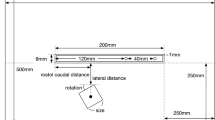Summary
By means of conditioning experiments it was demonstrated in the laboratory that catfish show compass-orientation using more or less homogeneous, horizontally directed electric fields. Similar fields occur in their habitat.
Evidence was found for the supposition that this kind of electro-orientation occurs spontaneously under natural circumstances.
The lowest current density (horizontal d.c. field) in which the catfish showed orientation behaviour proved to be 8 × 10−12A/mm2 in water with a specific resistivity of 25 Ohm·m.
Similar content being viewed by others
References
Andrianov, G. N., Ilyinsky, O. B.: Some functional properties of central neurons connected with the lateral-line organs of the catfish (Ictalurus nebulosus). J. comp. Physiol.86, 365–377 (1973)
Dijkgraaf, S.: Electroreception in the catfish,Amiurus nebulosus. Experientia (Basel)24, 187–188 (1968)
Fraenkel, G. S., Gunn, D. L.: The orientation of animals. Kineses, taxes and compass reactions. New York: Dover Publ. 1961
Kalmijn, A. J.: Bioelectric fields in sea water and the sensitivity of the ampullae of Lorenzini to stimuli of different modalities. CNRS & ZWO report, Utrecht (1969)
Kalmijn, A. J.: The electric sense of sharks and rays. J. exp. Biol.55, 371–383 (1971)
Murray, R. W.: The response of the ampullae of Lorenzini of Elasmobranchs to electrical stimulation. J. exp. Biol.39, 119–128 (1962)
Parker, G. H., Heusen, A. P. van: The response of the catfishAmiurus nebulosus to metallic and non-metallic rods. Amer. J. Physiol.44, 405–420 (1917)
Peters, R. C., Bretschneider, F.: Electric phenomena in the habitat of the catfishIctalurus nebulosus LeS. J. comp. Physiol.81, 345–362 (1972)
Peters, R. C., Buwalda, R. J. A.: Frequency response of the electro-receptors (“small pit organs”) of the catfish,Ictalurus nebulosus LeS. J. comp. Physiol.79, 29–38 (1972)
Peters, R. C., Meek, J.: Catfish and electric fields. Experientia (Basel)29, 299–300 (1973)
Roth, A.: Electroreception in the catfish,Amiurus nebulosus LeS. Z. vergl. Physiol.61, 196–202 (1968)
Roth, A.: Elektrische Sinnesorgane beim ZwergwelsIctalurus nebulosus (Amiurus nebulosus). Z. vergl. Physiol.65, 368–388 (1969)
Roth, A.: Wozu dienen die Elektrorezeptoren der Welse? J. comp. Physiol.79, 113–135 (1972)
Author information
Authors and Affiliations
Additional information
We are indebted to Prof. Dr. S. Dijkgraaf and Dr. F. J. Verheijen for their valuable suggestions, and to Mr. W. J. G. Loos for making the drawings.
Rights and permissions
About this article
Cite this article
Peters, R.C., van Wijland, F. Electro-orientation in the passive electric catfish,Ictalurus nebulosus LeS. J. Comp. Physiol. 92, 273–280 (1974). https://doi.org/10.1007/BF00696615
Received:
Issue Date:
DOI: https://doi.org/10.1007/BF00696615




